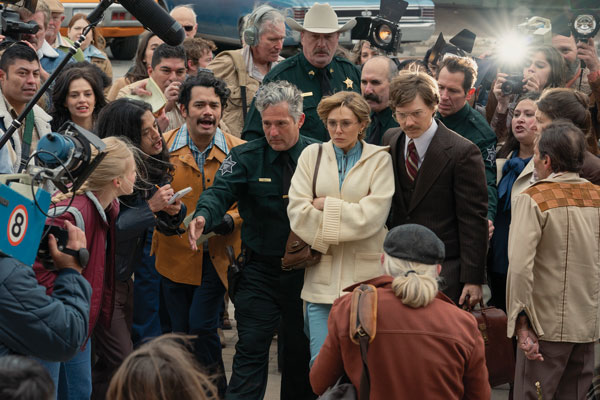There’s no escape from the digital age. As viewers, we have become accustomed to an array of new and enticing content that keep us locked in to our black boxes daily.
With the latest release of a movie, television show, video game or new music rarely do we consider every aspect behind our entertainment’s background. For those curious, a little research will show there’s a good chance that your earliest or latest obsession was inspired by and made in Texas.
The state not only continues to breed a plethora of household names, but has an indisputable way of drawing in new creatives. Texas knows to bank on growth within the nation’s entertainment industry, there had better be big bank backing it up.
U.S. states are scrambling to get resources in place to entice and adhere to the needs of multimillion-dollar productions ramping up across every facet of the industry. But none seem to move at the pace Texas leads with. In turn, the prevalent and steady growth within the entertainment industry comes from years of diligent planning and preparation accumulating among a network of Texas communities.
Looks Better on Film
Within both film and music, Texas has naturally served as a hotspot for industry growth for years. This has allowed the state to understand the needs of not only its local talent, but what it takes to support a full-scale production.
In 2023, the Texas Legislature put their money where their mouth is, scaling the state’s annual film incentive cap from $45 million up to $200 million. Albeit a lower incentive cap than long-established hubs like California, Georgia or New York, the state has taken an alternative route to entice productions.
By no means is the state a novice when it comes to film and television productions, leveraging more than 100 years as a prime set location. “Bonnie and Clyde,” “Friday Night Lights,” “Fear the Walking Dead,” “Love and Death,” “True Grit” and so many more iconic projects showcase that regardless of genre, Texas knows how to bring a vision to life, no studio set required. In 2023 the Film Friendly Texas Certified Community program added 14 new communities to a roster that now stands at over 175, touching every corner of the state.
The program has created a gold mine in terms of providing an extensive catalog of filming locations, skilled crew and local leadership equipped with industry knowledge and resources. Community leaders stay up to date on the latest industry regulations and best practices for film and digital media by attending regularly scheduled workshops held by the Texas Film Commission. That ensures that any project requests are swiftly fulfilled, preventing production slowdowns often faced in popular film hubs like California.
This preparation provides a ripple effect within these certified communities, providing a welcomed economic impact. Once a production team finds the ideal location(s), relevant communities can begin to coordinate supplies, crew, food, transportation and lodging, among other resources needed to see a production through. A full network, with dedicated regional industry professionals, allows filmmakers and crew to produce projects in a multitude of locations across the vast state with ease.
Qualifying film and television projects can additionally benefit from the Texas Moving Image Industry Incentive Program (TMIIIP) which provides cash grants from 5% for $250,000-$1 million of in-state spend, scaling up to 20% for $3.5 million or more of in-state spend. This program not only benefits filmmakers but harnesses local talent by requiring 55% of crew to be Texas residents. As of 2023, the program has generated over $2 billion and created 183,000 jobs.
While the majority of movie magic tends to take advantage of the best mother nature and human history have to offer, the most vital aspect of a production takes place indoors. Conscious of this and the rapid surge of Texas’ growth as a film hub, studio developers are taking note of the space Texas has to offer the entirety of a large-scale production.
The Austin region serves as a prime example and will soon gain studio space catered to serving this market long-term. In and around the Austin metro there are currently 28 studio facilities ranging from 250 to 237,000 sq. ft. that cover needs of small- to large-scale productions from equipment to post-production offices, services and amenities. But there’s always room for more, in this case much more.
In December 2024, Bastrop 552 plans to open up shop on the first 28 acres of its 600-acre film studio lot. Located 41 minutes outside of Austin in the city of Bastrop, this initial phase alone will bring up to 486,000 sq. ft. across eight studios, 300,000 sq. ft. of warehouse space and 200,000 sq. ft. of office space. While the timing of the next phase of the project is unknown, Bastrop 552 owner Alton Butler initially stated that the site would look to add more studios, warehouses, recreational areas and clubhouses.
A drive an hour southwest to San Marcos will take you to where Hill Country Studios will establish 200 acres of studios, workshops, production offices, a food park and on-site vendor village fit to exceed the needs of filmmakers and their crews. The $276 million studio investment was publicly announced in 2022, led by Hill Country Studios Co-Founder and CEO Cory McLoud and Chief Operating Officer Kevin Bar.
Construction is set to begin this year to build the initial seven sound stages, two workshops and a welcome center. Phase 1B will supply 250,000 sq. ft. of office space, while phase two completes five more sound stages, two workshops and support space.
Options are important, and the state’s harnessing plenty.
More to Music
“This Music Friendly Texas Community certification isn’t just about music, it’s about economic development and job creation,” said City of Galveston Mayor Craig Brown. “By embracing our music scene, we’re unlocking new opportunities for businesses and artists alike.”
The Music Friendly Texas Certified Community program designated the Gulf Coast city of Galveston as its 58th member in 2024. Started in 2016, and the first of its kind in the nation, the program has quickly gained traction in boosting the state’s influential music scene.
The economic impact can’t be ignored. The music industry in Texas held 192,000 jobs and generated $26 billion in economic activity in 2022, showing no signs slowing down. Texas has produced some of the most successful artists of our time, cultivating a state-wide ecosystem of industry talent. By showcasing opportunities right at home, it has quickly caught the attention of the nation.
March 2024 brought news of a $220 million venue investment from entertainment company Notes Live. The Sunset Amphitheater project will begin construction in McKinney, Texas, this year. By 2026, the company plans to unveil a 20,000-seat venue it promises will be “the largest and most luxurious amphitheater yet,” creating 1,300 new jobs. The project will provide a covered outdoor space, featuring 295 various sized fit pit suites, lounges with food and beverage service.
“I couldn’t be more excited to be bringing our biggest venue to date to McKinney, Texas,” says Notes Lives Founder and CEO JW Roth. “They say everything’s bigger in Texas, and for the Sunset Amphitheater in McKinney, that was our guiding principle — bigger, and better. McKinney is an incredible community, and we can’t wait to build the most over-the-top venue on earth.”
Interest in the future of artistic success also brought two of the industry’s most prolific award shows back to Texas. Over the next several years, Frisco and Austin will host the Academy of Country Music Awards and the Country Music Television Awards, respectively.
Embrace the Visual Appeal
Following in the footsteps of the state’s successful Film and Music Friendly Texas Certified Community programs, it was announced in February 2024 that Texas had established a new Digital Media Friendly Texas Certified Community program.
The new program differs in that its focus is specifically on targeting growth within animation, visual effects, video games and extended reality. For creatives interested, this program additionally introduces a slew of incentives and grants to help get the ball rolling.
“Animation, visual effects, video game and XR production are a vital part of the production ecosystem in Texas,” said Texas Film Commission Director Stephanie Whallon. “The Digital Media Friendly Texas Certified Community program represents a forward-thinking network of communities that not only understand the digital media production industries and their needs, but also their importance for driving continued economic growth and ability to showcase the technical skills and artistic creativity of Texas media professionals.”
Under TMIIIP, qualifications for video game projects include a $100,000 minimum spend, at least 60% of production takes place in Texas and 55% of paid crew be Texas residents. These projects can receive a cash grant up to 22.5% back on expenditures like wages, legal fees, travel and insurance. The only difference for animation and visual effects projects is that the minimum spend for film and television is $250,000, while commercials require at least $100,000. For productions that take advantage of hiring veterans, filming in underutilized or economically distressed areas or hosting post-production in the state, these projects can earn another 2.5% grant award toward their base incentive rate.
For creators looking for a permanent stay, building a facility in the state comes with perks. The Media Production Development Zone Act provides a sales use and tax exemption for the construction, maintenance, expansion, improvement or renovation of a production facility. This incentive spans projects for animation, video game development studios, sound stages, production offices and post-production facilities.
Gamer or not, video games created within the confines of Texas have been making an impact around the world since 1981. Call of Duty, Halo, Rock Band, Sims and Words With Friends are among the most popular games to find their start here. Moving forward, Texas is looking to cement its role in the next generation of video game development.
Whether it be on-screen or behind the scenes; in the production office or lunch at a local café; in a hotel or in a ride to set, the economic impact of the entertainment industry benefits Texas communities in a multitude of ways. In the end two facts remain true: Creatives thrive in Texas and new opportunities will continue to arise for them.

